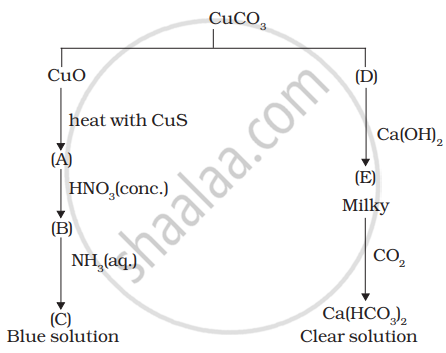Advertisements
Advertisements
Question
Why is the highest oxidation state of a metal exhibited in its oxide or fluoride only?
Solution
Due to its small size and high electronegativities, oxygen or fluorine elements can oxidize the metal to its higher oxidation state.
APPEARS IN
RELATED QUESTIONS
ln which pair highest oxidation states of transition metals are found:
The elements of 3d transition series are given as: Sc Ti V Cr Mn Fe Co
Answer the following: Which element has the highest m.p?
Which of the d-block elements may not be regarded as the transition elements?
Use Hund’s rule to derive the electronic configuration of Ce3+ ion and calculate its magnetic moment on the basis of ‘spin-only’ formula.
Which one of the following ions is coloured?
Give reasons: E° value for the Mn3+/Mn2+ couple is much more positive than that for Fe3+/Fe2+.
The transition metals show _________ character because of the presence of unpaired· electrons and Cu+ is ____________ because of its electronic configuration is [Ar]3d10
Read the passage given below and answer the following question:
The transition metals when exposed to oxygen at low and intermediate temperatures form thin, protective oxide films of up to some thousands of Angstroms in thickness. Transition metal oxides lie between the extremes of ionic and covalent binary compounds formed by elements from the left or right side of the periodic table. They range from metallic to semiconducting and deviate by both large and small degrees from stoichiometry. Since electron bonding levels are involved, the cations exist in various valence states and hence give rise to a large number of oxides. The crystal structures are often classified by considering a cubic or hexagonal close-packed lattice of one set of ions with the other set of ions filling the octahedral or tetrahedral interstices. The actual oxide structures, however, generally show departures from such regular arrays due in part to distortions caused by packing of ions of different size and to ligand field effects. These distortions depend not only on the number of d-electrons but also on the valence and the position of the transition metal in a period or group.
In the following questions, a statement of assertion followed by a statement of reason is given. Choose the correct answer out of the following choices on the basis of the above passage.
Assertion: Transition metals form protective oxide films.
Reason: Oxides of transition metals are always stoichiometric.
Electronic configuration of a transition element X in +3 oxidation state is [Ar]3d5. What is its atomic number?
The second and third rows of transition elements resemble each other much more than they resemble the first row. Explain why?
Identify A to E and also explain the reactions involved.

In the ground state of atomic Fe (Z = 26), the spin-only magnetic moment is ______ × 10-1 BM.
(Round off to the nearest integer).
[Given: `sqrt3 = 1.73, sqrt2 = 1.41`]
Which of the following transition metals shows +1 and +2 oxidation states?
Complete the following reaction and justify that it is a disproportionation reaction:
\[\ce{3MnO^{2-}4 + 4H^+ -> \underline{}\underline{}\underline{}\underline{} + \underline{}\underline{}\underline{}\underline{} + 2H2O}\]
Which of the following ions has the electronic configuration 3d6?
(Atomic number: Mn = 25, Co = 27, Ni = 28)
Give two similarities in the properties of Sc and Zn.
Write the ionic equation for reaction of KI with acidified KMnO4.
Explain the magnetic properties of d-block (or transition) elements.
Account for the following:
Zirconium (Zr) and Hafnium (Hf) are difficult to separate.
